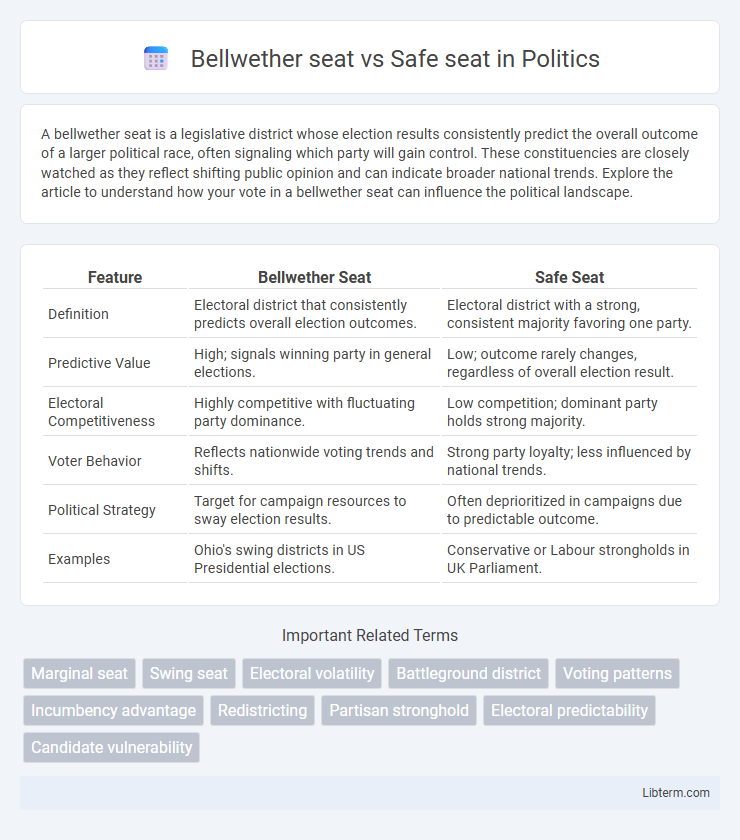A bellwether seat is a legislative district whose election results consistently predict the overall outcome of a larger political race, often signaling which party will gain control. These constituencies are closely watched as they reflect shifting public opinion and can indicate broader national trends. Explore the article to understand how your vote in a bellwether seat can influence the political landscape.
Table of Comparison
| Feature | Bellwether Seat | Safe Seat |
|---|---|---|
| Definition | Electoral district that consistently predicts overall election outcomes. | Electoral district with a strong, consistent majority favoring one party. |
| Predictive Value | High; signals winning party in general elections. | Low; outcome rarely changes, regardless of overall election result. |
| Electoral Competitiveness | Highly competitive with fluctuating party dominance. | Low competition; dominant party holds strong majority. |
| Voter Behavior | Reflects nationwide voting trends and shifts. | Strong party loyalty; less influenced by national trends. |
| Political Strategy | Target for campaign resources to sway election results. | Often deprioritized in campaigns due to predictable outcome. |
| Examples | Ohio's swing districts in US Presidential elections. | Conservative or Labour strongholds in UK Parliament. |
Understanding Bellwether Seats: Definition and Significance
Bellwether seats are electoral districts whose voting outcomes typically predict the overall result of an election, making them key indicators of broader political trends. These seats often experience closely contested races and reflect the prevailing public opinion, distinguishing them from safe seats, which are dominated by a single party with predictable outcomes. Understanding bellwether seats is crucial for strategists and analysts aiming to gauge election dynamics and forecast national or regional political shifts accurately.
What Is a Safe Seat in Politics?
A safe seat in politics refers to an electoral district consistently won by the same political party or candidate with a large majority, making it highly unlikely to change hands in elections. These seats provide guaranteed representation and stability for a party, influencing campaign strategies and resource allocation. In contrast, a bellwether seat is a constituency whose election results often predict the overall outcome of an election, reflecting broader voter trends.
Key Differences Between Bellwether and Safe Seats
Bellwether seats are electoral districts that historically predict the overall election outcome by consistently voting for the winning party, making them crucial indicators of political trends. Safe seats, in contrast, are strongholds where a particular party holds a significant majority, virtually guaranteeing their candidate's victory with minimal competition. The key difference lies in predictability and competitiveness: bellwether seats mirror the national mood and can swing between parties, while safe seats offer stability and minimal electoral uncertainty.
The Role of Bellwether Seats in Election Predictions
Bellwether seats serve as key indicators in election predictions by reflecting broader voting trends within a region, often aligning with the overall election outcome. Unlike safe seats, where a particular party consistently holds a strong majority, bellwether seats exhibit dynamic voter behavior that can swing between parties, providing critical insights into shifting political landscapes. Analyzing voting patterns in bellwether constituencies helps political analysts forecast national election results with greater accuracy.
Factors That Make a Seat ‘Safe’
A safe seat is characterized by a consistently high margin of victory for a particular political party, strong voter loyalty, and demographic stability within the electorate. Factors such as entrenched party organization, historical voting patterns, and socio-economic homogeneity contribute to the predictability of election outcomes in these constituencies. In contrast to bellwether seats, which are volatile and reflect national trends, safe seats exhibit minimal electoral fluctuations and secure incumbent successes.
Historical Examples of Influential Bellwether Seats
Bellwether seats like Ohio's 12th Congressional District have historically predicted U.S. presidential election outcomes by consistently aligning with the winning candidate since 1964. In the United Kingdom, the Sedgefield constituency served as a bellwether, electing Labour Party candidates during Tony Blair's leadership and reflecting national shifts. These influential bellwether seats contrast with safe seats, which exhibit longstanding loyalty to a single party regardless of broader electoral trends.
Why Safe Seats Rarely Change Hands
Safe seats rarely change hands due to strong voter loyalty, demographic stability, and significant party investment, ensuring consistent electoral outcomes. These constituencies feature entrenched political alignments, often influenced by socio-economic factors and historical voting patterns that reinforce incumbent dominance. In contrast, bellwether seats exhibit fluctuating voter behavior reflecting broader electoral trends, making safe seats unique in their resistance to political shifts.
Bellwether Seats and Their Impact on Election Strategies
Bellwether seats serve as critical indicators of overall election trends, often swinging with the prevailing political mood and thereby shaping campaign focus and resource allocation. Campaign strategists prioritize bellwether constituencies to gauge voter sentiment, adjust messaging, and predict national outcomes due to their historically predictive voting patterns. Unlike safe seats, which remain loyal to a single party, bellwether seats demand dynamic election strategies emphasizing voter engagement and issue responsiveness to influence tightly contested races.
Challenges and Criticisms of Safe Seats
Safe seats face significant challenges including diminished electoral competitiveness and reduced voter engagement, as incumbents often win with little opposition. Critics argue this leads to complacency among elected officials, weakening accountability and responsiveness to constituents. Such districts may also discourage political innovation and limit the diversity of representation in legislative bodies.
The Future of Bellwether and Safe Seats in Modern Elections
Bellwether seats, traditionally seen as indicators of overall election outcomes, face challenges due to shifting voter demographics and increased political polarization, reducing their predictive reliability. Safe seats, characterized by strong party loyalty, continue to dominate many legislatures but raise concerns about reduced electoral competition and voter engagement. The future of both types of seats depends on evolving electoral dynamics, including redistricting practices and changes in voter behavior shaped by social media and political mobilization strategies.
Bellwether seat Infographic

 libterm.com
libterm.com